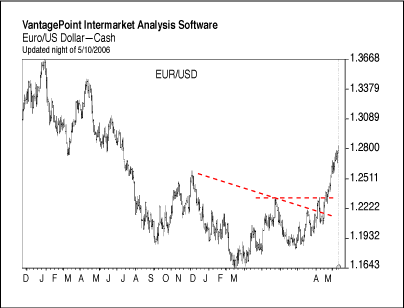Access to foreign exchange trading has opened up exciting trading options for the retail trader. You can now trade alongside corporations and institutions in a highly liquid market that is global, traded around the clock, and highly leveraged. Before jumping into this market, however, we must understand the factors that affect the forex market. With that in mind, STOCKS& COMMODITIES has introduced Forex Focus to better prepare the retail trader to participate in the currency market.
Euro Sparkling, But Faces Long-Term Challenges
Here's an overview of the Eurozone.
by Darrell Jobman
With a lack of confidence in the US dollar and central bank diversification away from the US currency, the euro is in position to make further gains over the next few months, to at least 1.30 against the dollar. The Eurozone area, however, faces tough decisions on economic reform, and government weaknesses in the major economies will make it even more difficult to secure approval for key measures such as labor market reforms. Without reform, Eurozone growth is likely to falter quickly in the face of higher interest rates, with the European Central Bank (ECB) taking a firm stance that realistically could normalize interest rates to at least the 3% level by year-end.
Eurozone growth and prospects for the euro will be particularly vulnerable if there is a downturn in global growth. In these circumstances, there would be pressure for a renewed cut in interest rates and action to curb euro strength. There will also be longer-term concerns over the balance of payments position and, at the extreme, fears that Italy could leave the euro arena. Euro gains, therefore, could prove to be fragile and temporary, with confidence faltering from late 2005.
EURO SPURT
The euro recorded strong gains during the spring months, rising above 1.28 against the dollar compared with levels close to 1.18 at the end of 2005 (Figure 1). Euro confidence has improved, although a loss of confidence in the dollar seems to have been the prime driving force.
Eurozone data has remained generally strong, with rising industrial confidence. The influential German IFO index, for example, rose to a 15-year high in April, and business confidence has improved. The April PMI index for the manufacturing sector rose to the highest level since 2000, and there was a firm report for the services sector.

FIGURE 1: THE EURO. The euro has been swinging higher against the US dollar in 2006, but economic growth prospects in the eurozone do not seem to support a move to the early 2005 highs.
The export sector across the Eurozone has been performing well, but domestic demand is still patchy. Consumer confidence remains subdued in contrast to rising business confidence, and German spending levels are still generally weak. For the Eurozone as a whole, retail sales fell 0.8% in March, producing a 0.2% annual decline. Gross domestic product (GDP) growth should be in a 2?2.5% range for 2006.
Return to September 2006 Contents
Originally published in the September 2006 issue of Technical Analysis
of STOCKS & COMMODITIES magazine. All rights reserved.
© Copyright 2006, Technical Analysis, Inc.